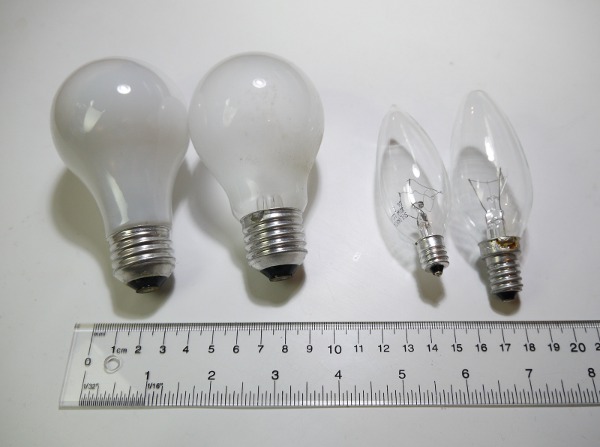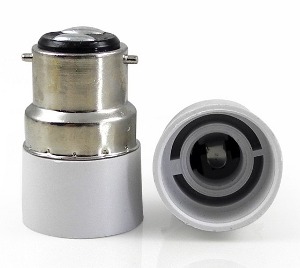
Light fixtures and light bulb sizes
The Edison screw (E..) is a standard socket for light bulbs developed by Thomas
Edison. There are a lot of exotic light bulbs however in practice only
a few common types are used.
Light bulbs with an Edison screw
On the packaging of bulbs for household lighting you will
normally find one of the following "size" designations.
- E27 European standard light bulb. Medium Edison screw, 27mm base diameter.
- E26 US standard light bulb base. Medium Edison screw, 26mm base diameter.
- E14 European small candle shape light bulb. Small Edison screw, 14mm base diameter.
- E12 US small candle shape light bulb base. Candelabra Edison screw, 12mm base diameter.
On most packages for those light bulbs you will not see any mentioning of E12.
It will normally just say B10 which is actually just specification of the shape
and glass diameter (not the base).
- B10 with a E12 base. The B10 refers to the glass diameter of a small US candle shape light bulb. The B10 bulb has a glass diameter 10*1/8inch.
- B13 with a E26 base. The B13 refers to the glass diameter of a US candle shape light bulb. The B13 bulb has a glass diameter 13*1/8inch.
- A19 with a E26 base. The A19 refers to the glass diameter of a US standard light bulb. The A19 bulb has a glass diameter of 19*1/8inch.
- A15 with a E26 base. The A15 refers to the glass diameter of a US kitchen appliance or ceiling fan light bulb. The A15 bulb has a glass diameter of 15*1/8inch.
- C7 with a E12 base. The C7 refers to the glass diameter of a US small night light bulb. The C7 bulb has a glass diameter of 7*1/8inch.
- PAR20 with a E26 base. Typical reflector light bulb for pot lights
integrated into the ceiling.
- PAR30 with a E26 base. Large reflector light bulb used for spot lights.
On the package of European light bulbs you will normally not find any numbering
describing the shape or diameter of the glass.
The light bulb is specified only by its
base and there will be photo showing the shape.

Four of the most common light bulbs: US A19 with E26, European E27, US B10
with E12, European E14
The E27 light bulb has slightly deeper grooves in the thread than
the E26 bulb base but the US light fixtures are less precise and have more slag than
the European ones. This results in the odd situation that most
E27 light bulbs (the supposedly bigger ones) will still fit well into a US E26 base but not the other
way round. You can however force it, it may feel tight and difficult to turn
but it will work.
Light bulbs and light sockets were in the past produced locally. With the
decline of incandescent light bulbs and the raise of more expensive
LED bulbs the production of those bulbs is moving to China. Those
China factories are producing for the world market and the result is a base
that has the outer diameter of a E26 base and groove depth of a E27 bulb.
The result is that LED bulbs fit now easily into either a European fixture or
a US standard fixture. The box will still say E26 or E27 depended
on the market but the light bulb will fit in either fixture and you just
have to make sure that the light bulb can take the voltage.
British light bulbs with a bayonet cap
"push and twist" light bulbs with a base known as Bayonet Cap (BC) are
fairly common in Great Britain but used nowhere else in the
world for domestic lighting.
- B22d, large Bayonet Cap light bulb, base diameter 22mm
- B15d, small Bayonet Cap light bulb, base diameter 15mm
Since this British bayonet cap is used exclusively in Britain it becomes
a problem when you are moving to another country. You can find now
adapters that allow you to use standard E14 or E27 light bulbs in
B22d fixtures.

Adapter to use light bulbs with an E14 base in British Bayonet Cap B22d light
fixtures.
Update 2025-11-09: Nathan Gonzales contacted me to let me know that New
Zealand uses also Bayonet Cap light bulbs.
240V.
Page maintained by Guido Socher, contact me via email at:

